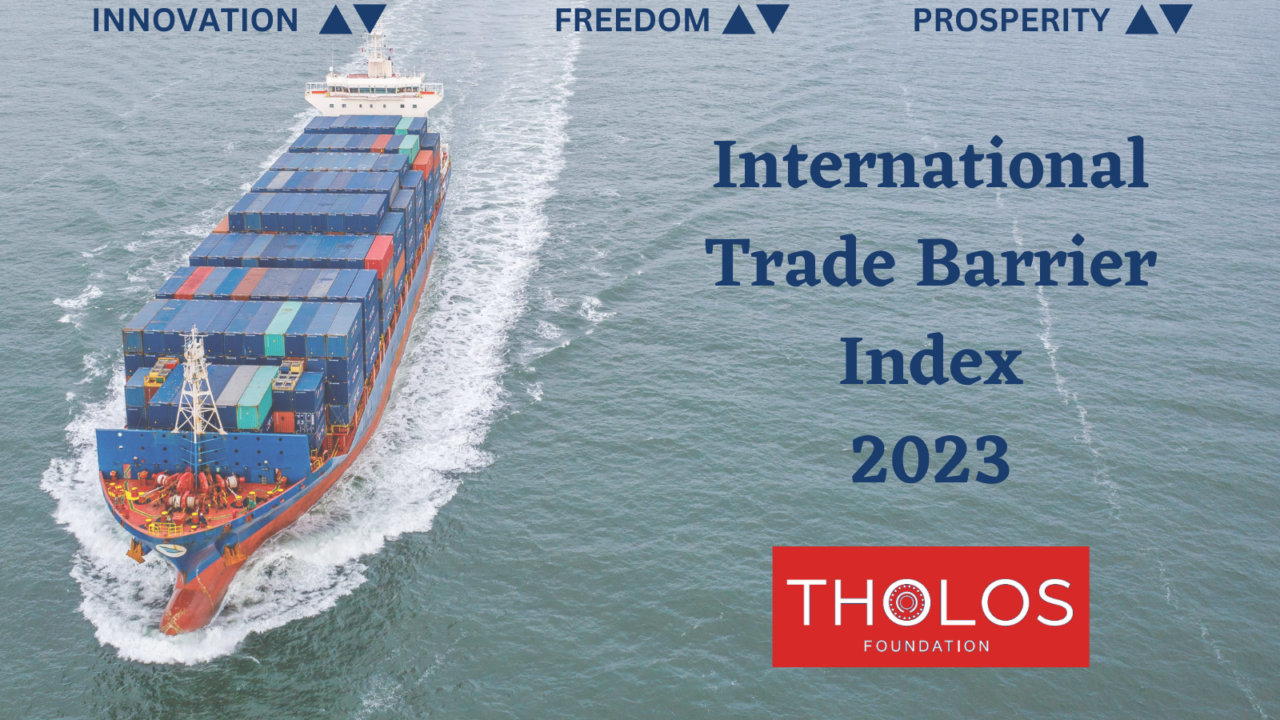
2023 International Trade Barrier Index
KUALA LUMPUR, MY –– 5/10/2023 –– The Tholos Foundation today released the 2023 International Trade Barrier Index. Singapore, New Zealand, and Japan scored the top spots for trade liberalization. While Indonesia, Russia, and India ranked the worst for deploying the most trade barriers.
The TBI measures direct and indirect trade barriers imposed by 88 countries affecting 72% of the world’s people and 96% of global GDP. The Index finds countries with lower trade barriers experience more prosperity, economic freedom, and freedom from corruption.
Countries with few trade barriers attain higher levels of productivity, prosperity, and human development. The six countries with the fewest trade barriers are home to 2.6 percent of the world’s people and produce 11 percent of global GDP. The two countries with the most trade barriers, Russia and India, are home to 20 percent of the world’s population and produce only five percent of global GDP.
Trade barriers are policy decisions that restrict the ability of individuals and institutions to reach mutually beneficial decisions on their own accord. The TBI records heavier use of tariff barriers in low-income and sub-Saharan African countries, while high-income countries deploy more non-tariff barriers and have led in imposing new digital trade restrictions. Upper-middle-income countries, South Asia, and Latin America impose more restrictions on services than others.
The Trade Facilitation component of the TBI, which includes effective property rights and a reliable logistics environment, ingredients crucial to curbing illicit trade, has worsened in upper-middle- and low-income countries.
Key Findings
The United States drops from 51st to 65th. It’s true the United States has low tariffs — it ranks 24th in that category — yet it imposes more non-tariff barriers than any other country, a trend that has continued with the Inflation Reduction Act. In addition, the United States has not joined additional free-trade agreements and has proposed several digital trade restrictions that would regulate speech online.
In the 2023 edition, Western Europe led over India, China and Russia in proposing and implementing new digital trade restrictions. The regulations in the Digital Markets Act, Digital Services Act, the proposed Cloud Certification Scheme, and others from the European Union experiment in adding restrictions that discriminate on harmful but not illegal content, market size, as well as the physical location of data storage and processing.
High-income countries impose the fewest services restrictions while lower-middle-income countries impose several restrictions on foreign ownership, investment, and working professionals that can sometimes be considered as part of coerced technology transfers scheme.
The UK continues to liberalize its tariff barriers in contrast to the European Union (EU). Its Most Favored Nation (MFN) tariff rate is 3.9 percent as opposed to 5.2 percent in the EU and most lines are duty-free, where only 29 percent of tariff lines enjoy the same preference in the EU. The UK has also been able to sign new trade agreements.
The East Asia and Pacific region contains the highest variability in scores. It includes some of the most trade-open countries: Singapore, New Zealand, Japan, Hong Kong, and Australia, and some of the most trade restrictive: China, the Philippines, Thailand, and Indonesia. This indicates an environment vulnerable to pervasive illegal trade.
The release of the Index took place at the South East Asia Innovation Summit where Philip Thompson, the author of the Index, warned, “Today we’re hearing more calls for autarky, they call it friend shoring, decoupling, reshoring, and the targets are increasingly trade between close allies and trade partners.” Thompson remarked, “This is a sign of potential conflict not peace.”
The Index includes case studies from leading free-market think tanks that examine the impact of trade barriers and trade liberalization on the ground. The case studies cover the rise of digital trade restrictions, non-tariff barriers on vaping products, intervention in Mexico’s energy markets, curbing illicit trade of pharmaceutical products in Asia and much more. Check https://tradebarrierindex.org/ for updated case studies throughout the year.
· Strengthening U.S. Supply Chains Through Trade: The Case of Taiwan; By Tori K. Smith, Director of International Economic Policy at the American Action Forum, USA
· EU Protectionist Digital Trade Barriers Restrict Innovation and Diminish Competition; By Philip Thompson and Andreas Hellmann, the Tholos Foundation and Americans for Tax Reform, USA
· Time for a Pause and Rethink: India’s Evolving Stand on Foreign Trade; By Ashish Bharadwaj, Founding Dean of BITS Law School, India
· Energy Policy as Coercion: A Chronic Squelch of Free Markets; By Ana Lilia Moreno, Coordinator of Competition and Regulation, México Evalúa, Mexico
Survey of Trade Restrictions Applied to Harm Reducing Nicotine Products; Tim Andrews and Nele all, Tholos Foundation, USA
· Analyzing the Foreign Subsidies Regulation as a Trade Defense Measure; By Arian Aghashahi, The Republic, Germany
· Moving Up the Ladder: Can Post COVID-19 Indonesia Become a Global Pharmaceutical Powerhouse?; Alfian Banjaransari, Center for Market Education, Indonesia
Contact: Philip Thompson
Email: P[email protected]